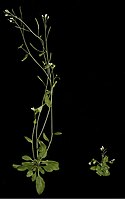
Allosteric Control of a Plant Receptor Kinase through S-Glutathionylation.
Sign Up to like & getrecommendations! Published in 2017 at "Biophysical journal"
DOI: 10.1016/j.bpj.2017.08.059
Abstract: Growing evidence supports the importance of protein S-glutathionylation as a regulatory post-translational modification with functional consequences for proteins. Discoveries of redox-state-dependent protein kinase S-glutathionylation have fueled discussion of redox-sensitive signaling. Following previously published experimental evidence… read more here.
Keywords: protein; glutathionylation; kinase; receptor ... See more keywords

Phosphorylation of ATG18a by BAK1 suppresses autophagy and attenuates plant resistance against necrotrophic pathogens
Sign Up to like & getrecommendations! Published in 2020 at "Autophagy"
DOI: 10.1080/15548627.2020.1810426
Abstract: ABSTRACT Autophagy is critical for plant defense against necrotrophic pathogens, which causes serious yield loss on crops. However, the post-translational regulatory mechanisms of autophagy pathway in plant resistance against necrotrophs remain poorly understood. In this… read more here.
Keywords: plant; bak1; thaliana; plant resistance ... See more keywords

Receptor-like protein kinase BAK1 promotes K+ uptake by regulating H+-ATPase AHA2 under low potassium stress.
Sign Up to like & getrecommendations! Published in 2022 at "Plant physiology"
DOI: 10.1093/plphys/kiac237
Abstract: Potassium (K+) is one of the essential macronutrients for plant growth and development. However, the available K+ concentration in soil is relatively low. Plant roots can perceive low K+ (LK) stress, then enhance high-affinity K+… read more here.
Keywords: protein kinase; bak1; receptor like; like protein ... See more keywords

Specifying the role of BAK1-interacting receptor-like kinase 3 in brassinosteroid signaling.
Sign Up to like & getrecommendations! Published in 2019 at "Journal of integrative plant biology"
DOI: 10.1111/jipb.12803
Abstract: Brassinosteroids (BR) are involved in the control of several developmental processes ranging from root elongation to senescence and adaptation to environmental cues. Thus, BR perception and signaling have to be precisely regulated. One regulator is… read more here.
Keywords: kinase; bak1 interacting; bir3; interacting receptor ... See more keywords

BAK1 plays contrasting roles in regulating abscisic acid-induced stomatal closure and abscisic acid-inhibited primary root growth in Arabidopsis.
Sign Up to like & getrecommendations! Published in 2022 at "Journal of integrative plant biology"
DOI: 10.1111/jipb.13257
Abstract: The mechanisms that balance plant growth and stress responses are poorly understood, but they appear to involve abscisic acid (ABA) signaling mediated by protein kinases. Here, to explore these mechanisms, we examined the responses of… read more here.
Keywords: primary root; growth; bak1; abscisic acid ... See more keywords

Deletion of Bak1 alleviates microglial necroptosis and neuroinflammation after experimental subarachnoid hemorrhage
Sign Up to like & getrecommendations! Published in 2022 at "Journal of Neurochemistry"
DOI: 10.1111/jnc.15751
Abstract: Microglial necroptosis exacerbates neurodegenerative diseases, central nervous system (CNS) injury, and demonstrates a proinflammatory process, but its contribution to subarachnoid hemorrhage (SAH) is poorly characterized. BCL‐2 homologous antagonist‐killer protein (Bak1), a critical regulatory molecule of… read more here.
Keywords: necroptosis; microglial necroptosis; subarachnoid hemorrhage; bak1 ... See more keywords

Immune responses induced by oligogalacturonides are differentially affected by AvrPto and loss of BAK1/BKK1 and PEPR1/PEPR2.
Sign Up to like & getrecommendations! Published in 2017 at "Molecular plant pathology"
DOI: 10.1111/mpp.12419
Abstract: Plants possess an innate immune system capable of restricting invasion by most potential pathogens. At the cell surface, the recognition of microbe-associated molecular patterns (MAMPs) and/or damage-associated molecular patterns (DAMPs) by pattern recognition receptors (PRRs)… read more here.
Keywords: loss bak1; immune responses; bak1 bkk1; bak1 ... See more keywords

Untargeted Metabolomics Profiling of Arabidopsis WT, lbr-2-2 and bak1-4 Mutants Following Treatment with Two LPS Chemotypes
Sign Up to like & getrecommendations! Published in 2022 at "Metabolites"
DOI: 10.3390/metabo12050379
Abstract: Plants perceive pathogenic threats from the environment that have evaded preformed barriers through pattern recognition receptors (PRRs) that recognise microbe-associated molecular patterns (MAMPs). The perception of and triggered defence to lipopolysaccharides (LPSs) as a MAMP… read more here.
Keywords: bak1 mutants; lbr bak1; lps chemotypes; bak1 ... See more keywords